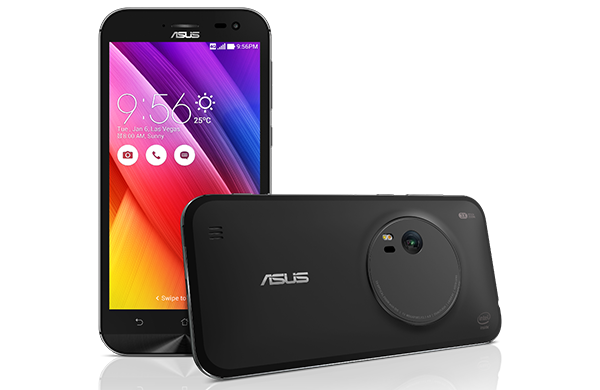Asus ZenFone Zoom 3X Optical Zoom Smartphone, Detailed
Way back at the beginning of the year, Asus announced two new smartphones at CES. The first was the ZenFone 2, which we recently reviewed and liked a lot, giving it our "Editor Recommended" award. The other phone was the ZenFone Zoom. Unfortunately, at CES this phone was only on display under glass and was clearly not ready for prime time.
All we knew back then was that it was also going to be an Intel Atom-powered smartphone equipped with an impressive-sounding 3x optical zoom camera. Now, eight months later at IFA, Asus has taken the wraps off the finished product and announced the full specifications of its Galaxy Camera killer. Unfortunately, although Asus is happy to share the Zoom's specs with the world, no information on pricing or availability was released, though at CES we were told it would be $400.
Specifications
| Product | Asus ZenFone Zoom |
|---|---|
| Display | 5.5-inch IPS @ 1920 x 1080 (403 PPI), Gorilla Glass 4 |
| SoC | Intel Atom Z3590 (Moorefield) |
| CPU Core | Silvermont (4x @ 2.5 GHz) |
| GPU Core | PowerVR G6430 @ 640 MHz |
| Memory | 4 GB LPDDR3 |
| Storage | Up to 128 GB, microSD |
| Battery | 3,000 mAh, non-removable |
| Front Camera | 5 MP, 1/5" OmniVision OV5670, 1.12μm, f2.0 |
| Rear Camera | 13 MP Panasonic 1.12um Pixel 1/3.06" SmartFSI sensor (?), f/2.7 - f/4.8 10-element Hoya lens, 3x optical zoom, OIS, laser AF, dual-LED 'Real Tone' flash |
| Connectivity | Wi-Fi 802.11a/b/g/n/ac, Bluetooth 4.0, NFC (?), 4G LTE (Cat 4), microUSB 2.0 |
| Special Features | Dual Active SIM (?), BoostMaster Quick Charge |
| OS | Android 5.0 (ZenUI) |
| Materials | Aluminum, Plastic |
| Color | Pure Black or Ceramic White |
| Size | 158.90 x 78.84 x 5 - 11.95 mm, 185 g |
Of course, the raison d'être for this phone is its camera, so let's go over it in a bit more detail. Back at CES we were given most of the information about it, including that it has a 10-element 3x optical zoom lens, OIS, and laser AF, but we weren't told anything about the sensor choice. Unlike the regular ZenFone 2, Asus has tapped Panasonic instead of Toshiba for the Zoom's sensor using, according to the press release, a 13 MP Panasonic SmartFSI sensor.
Although we can't be sure that this phone isn't using a new as-yet unreleased Panasonic sensor instead, but if it isn't, then this is likely the sensor model. This would mean that the Zoom's sensor was released in 2013 and is fairly small at 1/3.06". However, size isn't everything, and Panasonic does make excellent camera sensors, so its raw specs probably don't tell the whole story. Asus claimed that the ZenFone Zoom "captures more light and more color" than other phones.
This sensor is coupled with a 10-element 3x optical zoom lens from Hoya. Impressively, unlike the Galaxy Camera, the zoom lens does not protrude from the phone when in use, which allows Asus to claim that the Zoom is "the world's thinnest optical zoom smartphone." The Zoom also has optical image stabilization (OIS) and laser AF. Asus claimed a focus time of 0.2 seconds. The company did not include any information about the lens's aperture, so the specs we list above are what we were provided at CES.
As you can see in the picture above, the Zoom has a dedicated camera shutter button, a smaller one to activate video recording, and physical controls for the zoom lens (the volume rocker). Also, unlike the all-plastic ZenFone 2, the Zoom has an aluminum unibody that forms the sides and area surrounding the lens. The rest of the back of the phone is plastic and is removable to access the SIM and microSD slots. We assume that the Zoom is a dual-SIM device like the ZenFone 2, but we can't be sure. We also assume that the ZenFone's 3,000 mAh battery isn't removable.
Rounding out the camera component of the Zoom are the features enabled by the ZenUI Camera app. The Zoom can take macro photos as near as 5 cm (2 in), and the software can also combine four 13MP images into one 52MP "Super Resolution" image. The Zoom also has full manual camera control, including adjustment of the shutter speed, exposure, white balance and ISO.
Get Tom's Hardware's best news and in-depth reviews, straight to your inbox.
As for the rest of the Zoom's specs, they are, unsurprisingly, very similar to the ZenFone 2. The Zoom also utilizes a quad-core Intel Atom SoC, but Asus has equipped it with the new Z3590. This chip has a higher clock speed (2.5 GHz vs. 2.3 GHz) and faster GPU speed (640 MHz vs. 533 MHz) than the Z3580 found in the older ZenFone. This should make the Zoom the most powerful Asus phone yet.
All the other features are basically the same, including the 5.5-inch IPS 1080p display and 4 GB of RAM. The Zoom will be available with up to 128 GB of internal storage. The last specification we are not clear on is if the Zoom will still be running Android 5.0 with Asus's ZenUI, or will be updated to 5.1.
As we mentioned at the top of this post, Asus didn't release any information about pricing and availability of the ZenFone Zoom at IFA, though we can assume it will arrive sooner than later. As for pricing, we were told $400 at CES, but that was some time ago, so that may have changed -- and of course there is no word on whether this phone will even come to North America.

